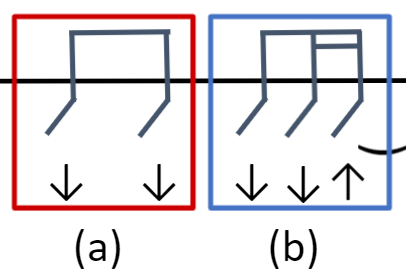This article is for people who:
・want to know how to play and practice 16 beat strokes
・want to play rhythms other than 8 beats
(1) 16 beat basic pattern A
*In this article, we will explain everything with the left hand holding the C chord.
First, to get an idea, let’s play 8 beats and 16 beats at the same tempo (bpm=100).
After playing an 8-beat stroke, try playing a 16-beat stroke.
You can see that the right hand moves much faster than the 8 beat.
(2) How to experience the sensation of 16 beats
i) First, try playing the following score (8-beat rhythm).
The tempo is BPM=60.
Play by alternating the downstroke (struck the strings from top to bottom) and the upstroke (struck the strings from bottom to top).

ii) Next, try playing as follows. Although they are the same on the musical score, they are all played with downstrokes (struck the strings from top to bottom).

iii) Now, while moving your right hand at the same speed, try adding an upstroke (red part in the image below).
Play by alternating downstrokes and upstrokes.

In the video below, I played the score iii) after the score ii).
At this time, the speed at which the right hand moves is the speed at which the right hand moves when playing 16 beats.
I think you can now get a little feel for 16 beats.
(3) Basic pattern of 16 beats
The basic pattern of 16 beats is shown in musical notation.
The pattern will look like this:

I think it’s quite difficult, but once you memorize it, it’s a basic pattern that can be used in a variety of songs, so please refer to the next heading “(4) How to practice” and try practicing.
First, try playing slowly at BPM=60. Tips and practice methods for changing guitar chords I will introduce a web page where you can use a metronome.
I think you can use it intuitively, but if you don’t know how to use it, please refer to the article below that explains how to use it.
Tips and practice methods for changing guitar chords
(4) Practice method
Let’s divide the 16-beat basic pattern shown above into three patterns.

i) (a)

(a) is simply two downstrokes.
I don’t think this is that difficult.
ii) (b)

(b) is two downstrokes and following One upstroke
(a)+(b)
Once you can play (a) and (b), try playing the pattern (a) + (b).

iii) (c)
I think (c) is the most difficult.
First, empty pick with a downstroke movement.
(Similar to the stroke, move your right hand from top to bottom of the strings, but do not pluck the strings.)
Then continue with upstroke ⇒ downstroke.

It’s like this.
Practice slowly and repeatedly until you get the hang of it.
I think it’s best to not push yourself too hard and get used to it little by little.
(c)+(b)
Once you can play (b) and (c), try playing the (c)+(b) pattern.

Once this is done, combine (a)+(b) and (c)+(d) to complete the basic pattern.

First, practice at BPM = 60, and once you can play, gradually increase the speed (about 10 BPM increments).
Practice until you can finally play at around BPM=100.



